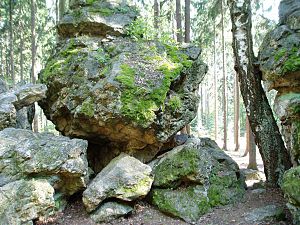White stone (Spitzkunnersdorf)
| White stone | ||
|---|---|---|
| height | 420 m above sea level NN | |
| location | Free State of Saxony , Germany | |
| Mountains | Lusatian highlands | |
| Coordinates | 50 ° 55 ′ 41 ″ N , 14 ° 40 ′ 13 ″ E | |
|
|
||
| rock | Quartzite | |
| particularities | Karasek Cave | |
The White Stone is a rock formation up to six meters high in the Hofebusch near Spitzkunnersdorf in Upper Lusatia . The so-called Karasek cave was formed in this rock through erosion .
geology
The white stone consists mostly of quartzite and muscovite flakes . It belongs to the same corridor that also passes the Waldschlößchen near Seifhennersdorf and continues west to Šluknov . The rock with a thickness of up to 50 meters has a white to yellow, sometimes reddish or brown color. Due to the steep collapse of the rock layer, it acts as a groundwater barrier, causing the springs to the north to dry up in summer.
Due to the different degrees of hardness of the rock, blocks, rock debris and shaft-like cavities were created during the erosion of the rock.
Karasek Cave
At the end of the 18th century, the robber chief Johannes Karasek set up a meeting point for his gang on this rock massif, which also included a cave in the White Stone. It is also popularly said that Karasek should have buried a treasure here.
literature
- The south-eastern Upper Lusatia with Zittau and the Zittau Mountains (= values of the German homeland . Volume 16). 2nd Edition. Akademie Verlag, Berlin 1971, p. 108.
Individual evidence
- ↑ Karasek Cave. Retrieved April 2, 2012 .

